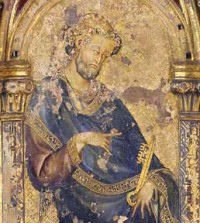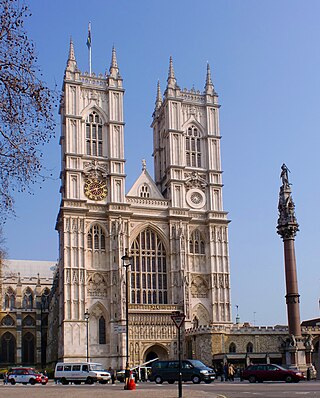
Westminster Abbey, formally titled the Collegiate Church of Saint Peter at Westminster, is an Anglican church in the City of Westminster, London, England. Since 1066, it has been the location of the coronations of 40 English and British monarchs, and a burial site for 18 English, Scottish, and British monarchs. At least 16 royal weddings have taken place at the abbey since 1100.
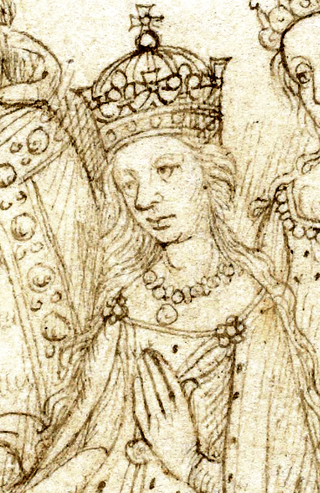
Catherine of Valois or Catherine of France was Queen of England from 1420 until 1422. A daughter of Charles VI of France, she was married to Henry V of England and was the mother of Henry VI. Catherine's older sister Isabella had also been a Queen of England as the child bride of Richard II. Catherine's marriage was part of a plan to eventually place Henry V on the throne of France, and perhaps end what is now known as the Hundred Years' War. But, although her son Henry VI was later crowned in Paris, this ultimately failed.

George Vertue was an English engraver and antiquary, whose notebooks on British art of the first half of the 18th century are a valuable source for the period.

An altarpiece is an artwork such as a painting, sculpture or relief representing a religious subject made for placing at the back of or behind the altar of a Christian church. Though most commonly used for a single work of art such as a painting or sculpture, or a set of them, the word can also be used of the whole ensemble behind an altar, otherwise known as a reredos, including what is often an elaborate frame for the central image or images. Altarpieces were one of the most important products of Christian art especially from the late Middle Ages to the era of the Counter-Reformation.

Grinling Gibbons was an Anglo-Dutch sculptor and wood carver known for his work in England, including Windsor Castle, the Royal Hospital Chelsea and Hampton Court Palace, St Paul's Cathedral and other London churches, Petworth House and other country houses, Trinity College, Oxford, and Trinity College, Cambridge. Gibbons was born to English parents in Holland, where he was educated.
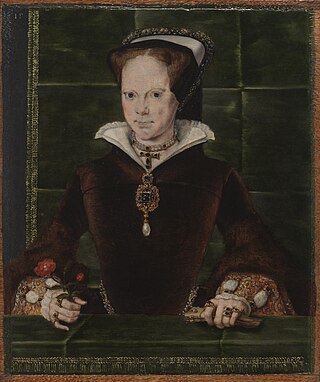
Hans Eworth was a Flemish painter active in England in the mid-16th century. Along with other exiled Flemings, he made a career in Tudor London, painting allegorical images as well as portraits of the gentry and nobility. About 40 paintings are now attributed to Eworth, among them portraits of Mary I and Elizabeth I. Eworth also executed decorative commissions for Elizabeth's Office of the Revels in the early 1570s.

The Henry VII Lady Chapel, now more often known just as the Henry VII Chapel, is a large Lady chapel at the far eastern end of Westminster Abbey, England, paid for by the will of King Henry VII. It is separated from the rest of the abbey by brass gates and a flight of stairs.

The Wilton Diptych is a small portable diptych of two hinged panels, painted on both sides, now in the National Gallery, London. It is an extremely rare survival of a late medieval religious panel painting from England. The diptych was painted for King Richard II of England, who is depicted kneeling before the Virgin and Child in what is known as a donor portrait. He is presented to them by the English saints King Edmund the Martyr, King Edward the Confessor and patron saint, John the Baptist. The painting is an outstanding example of the International Gothic style, and the nationality of the unknown artist is probably French or English.

The Painted Chamber was part of the medieval Palace of Westminster. It was gutted by fire in 1834, and has been described as "perhaps the greatest artistic treasure lost in the fire". The room was re-roofed and re-furnished to be used temporarily by the House of Lords until 1847, and it was demolished in 1851.

John de Critz or John Decritz was one of a number of painters of Flemish origin active at the English royal court during the reigns of James I of England and Charles I of England. He held the post of Serjeant Painter to the king from 1603, at first jointly with Leonard Fryer and from 1610 jointly with Robert Peake the Elder.

Alexander of Abingdon, also known as Alexander Imaginator or Alexander le Imagineur, was one of the leading sculptors of England around 1300.
The Westminster Abbey Museum was located in the 11th-century vaulted undercroft beneath the former monks' dormitory in Westminster Abbey, London, England. This was located in one of the oldest areas of the abbey, dating back almost to the foundation of the Romanesque church by Edward the Confessor in 1065. This space had been used as a museum since 1908.

Nottingham alabaster is a term used to refer to the English sculpture industry, mostly of relatively small religious carvings, which flourished from the fourteenth century until the early sixteenth century. Alabaster carvers were at work in London, York and Burton-on-Trent, and many probably worked very close to the rural mines, but the largest concentration was around Nottingham. This has led to all the English medieval output being referred to as "Nottingham alabaster".
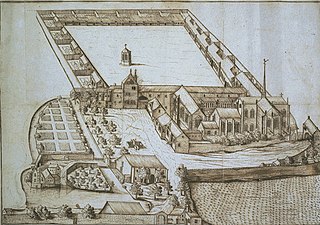
The Chartreuse de Champmol, formally the Chartreuse de la Sainte-Trinité de Champmol, was a Carthusian monastery on the outskirts of Dijon, which is now in France, but in the 15th century was the capital of the Duchy of Burgundy. The monastery was founded in 1383 by Duke Philip the Bold to provide a dynastic burial place for the Valois Dukes of Burgundy, and operated until it was dissolved in 1791, during the French Revolution.
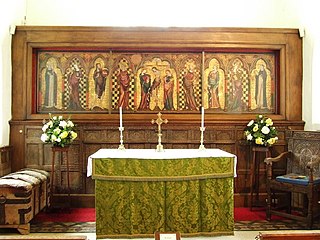
The Hamilton Kerr Institute is a branch of the Fitzwilliam Museum in Cambridgeshire, England, dedicated to the study and conservation of easel paintings. It is also part of the University of Cambridge.

The Westminster Psalter, British Library, MS Royal 2 A XXII, is an English illuminated psalter of about 1200, with some extra sheets with tinted drawings added around 1250. It is the oldest surviving psalter used at Westminster Abbey, and is presumed to have left Westminster after the Dissolution of the Monasteries. It joined the Old Royal Library as part of the collection of John Theyer, bought by Charles II of England in 1678. Both campaigns of decoration, both the illuminations of the original and the interpolated full-page drawings, are important examples of English manuscript painting from their respective periods.

Ralph Heimans, is an Australian-British contemporary portrait painter based in London, England. He is considered to be "one of today's leading portrait artists". He is best known for his large-scale Royal portraits of Queen Elizabeth II, Charles, Prince of Wales, and Prince Philip, Duke of Edinburgh, along with portraits of leading contemporary cultural figures. In 2014, Heimans was awarded a Member of the Order of Australia for Services to Portraiture.

Walter of Durham was a thirteenth-century painter and craftsman who was in service to Henry III and his son Edward I. Details of his life have been ascertained from records in royal ledgers, which show that his son Thomas of Westminster followed the same career. Walter's work, principally in Westminster Palace and Westminster Abbey, included the decoration of the walls and ceiling of the Painted Chamber, the painting and gilding of royal tombs, and the construction of the Coronation Chair to house the Stone of Scone.

The Coronation Theatre: Portrait of HM Queen Elizabeth II was painted by Ralph Heimans in 2012 to mark the Diamond Jubilee of Queen Elizabeth II. While the sitting took place in Buckingham Palace, the Queen is portrayed in Westminster Abbey, standing at the centre of the Cosmati pavement where she had been crowned 60 years previously. The mosaic pavement, referred to by Shakespeare as "the floor of heaven", is rich in symbolism and was created to evoke the "eternal pattern of the universe". It has been an integral part of the coronation ceremony since Henry III of England and is where every English monarch has been crowned for the last 900 years.

Perpendicular Gothic architecture was the third and final style of English Gothic architecture developed in the Kingdom of England during the Late Middle Ages, typified by large windows, four-centred arches, straight vertical and horizontal lines in the tracery, and regular arch-topped rectangular panelling. Perpendicular was the prevailing style of Late Gothic architecture in England from the 14th century to the 17th century. Perpendicular was unique to the country: no equivalent arose in Continental Europe or elsewhere in the British Isles. Of all the Gothic architectural styles, Perpendicular was the first to experience a second wave of popularity from the 18th century on in Gothic Revival architecture.

